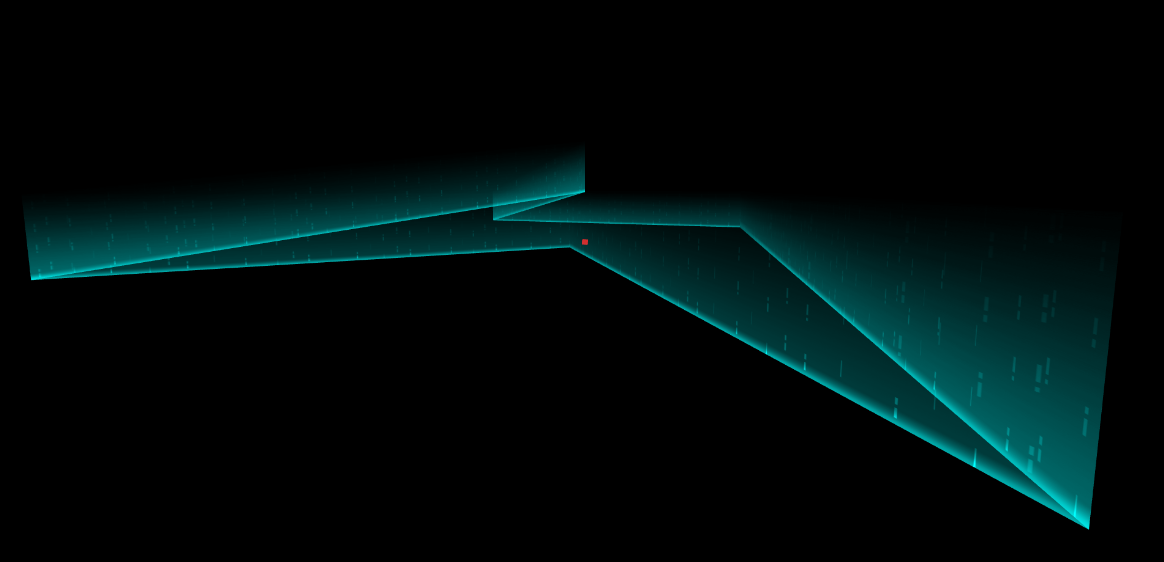threejs之创建发光墙体
threejs之创建发光墙体
组件文件:
图片两张:
bgImg.png

flowImg.png(图片是透明的,页面上看不到)

组件文件:
import * as THREE from 'three';
import bgImg from '/scene3D/bgImg.png'
import flowImg from '/scene3D/flowImg.png'
/**
* 创建流体墙体材质
* option =>
* params bgUrl flowUrl
* **/
const createWallMaterial = ({
bgTexture,
flowTexture
}) => {
// 顶点着色器
const vertexShader = `
varying vec2 vUv;
varying vec3 fNormal;
varying vec3 vPosition;
void main(){
vUv = uv;
vPosition = position;
vec4 mvPosition = modelViewMatrix * vec4( position, 1.0 );
gl_Position = projectionMatrix * mvPosition;
}
`;
// 片元着色器
const fragmentShader = `
uniform float time;
varying vec2 vUv;
uniform sampler2D flowTexture;
uniform sampler2D bgTexture;
void main( void ) {
vec2 position = vUv;
vec4 colora = texture2D( flowTexture, vec2( vUv.x, fract(vUv.y - time )));
vec4 colorb = texture2D( bgTexture , position.xy);
gl_FragColor = colorb + colorb * colora;
}
`;
// 允许平铺
flowTexture.wrapS = THREE.RepeatWrapping;
return new THREE.ShaderMaterial({
uniforms: {
time: {
value: 0,
},
flowTexture: {
value: flowTexture,
},
bgTexture: {
value: bgTexture,
},
},
transparent: true,
depthWrite: false,
depthTest: false,
side: THREE.DoubleSide,
vertexShader: vertexShader,
fragmentShader: fragmentShader,
});
};
/**
* 通过path构建墙体
* option =>
* params height path material expand(是否需要扩展路径)
* **/
export const creatWallByPath = ({
height = 10,
path = [],
material,
expand = true,
}) => {
let verticesByTwo = null;
// 1.处理路径数据 每两个顶点为为一组
if (expand) {
// 1.1向y方向拉伸顶点
verticesByTwo = path.reduce((arr, [x, y, z]) => {
return arr.concat([
[
[x, y, z],
[x, y + height, z],
],
]);
}, []);
} else {
// 1.2 已经处理好路径数据
verticesByTwo = path;
}
// 2.解析需要渲染的四边形 每4个顶点为一组
const verticesByFour = verticesByTwo.reduce((arr, item, i) => {
if (i === verticesByTwo.length - 1) return arr;
return arr.concat([[item, verticesByTwo[i + 1]]]);
}, []);
// 3.将四边形面转换为需要渲染的三顶点面
const verticesByThree = verticesByFour.reduce((arr, item) => {
const [[point1, point2], [point3, point4]] = item;
return arr.concat(
...point2,
...point1,
...point4,
...point1,
...point3,
...point4
);
}, []);
const geometry = new THREE.BufferGeometry();
// 4. 设置position
const vertices = new Float32Array(verticesByThree);
geometry.setAttribute("position", new THREE.BufferAttribute(vertices, 3));
// 5. 设置uv 6个点为一个周期 [0, 1, 0, 0, 1, 1, 0, 0, 1, 0, 1, 1]
// 5.1 以18个顶点为单位分组
const pointsGroupBy18 = new Array(verticesByThree.length / 3 / 6)
.fill(0)
.map((item, i) => {
return verticesByThree.slice(i * 3 * 6, (i + 1) * 3 * 6);
});
// 5.2 按uv周期分组
const pointsGroupBy63 = pointsGroupBy18.map((item, i) => {
return new Array(item.length / 3)
.fill(0)
.map((it, i) => item.slice(i * 3, (i + 1) * 3));
});
// 5.3根据BoundingBox确定uv平铺范围
geometry.computeBoundingBox();
const { min, max } = geometry.boundingBox;
const rangeX = max.x - min.x;
const uvs = [].concat(
...pointsGroupBy63.map((item) => {
const point0 = item[0];
const point5 = item[5];
const distance =
new THREE.Vector3(...point0).distanceTo(new THREE.Vector3(...point5)) /
(rangeX / 10);
return [0, 1, 0, 0, distance, 1, 0, 0, distance, 0, distance, 1];
})
);
geometry.setAttribute(
"uv",
new THREE.BufferAttribute(new Float32Array(uvs), 2)
);
// 更新法线
// geometry.computeVertexNormals();
const meshMat =
material ||
new THREE.MeshBasicMaterial({
color: 0x00ffff,
side: THREE.DoubleSide,
});
return new THREE.Mesh(geometry, material);
};
// 创建墙体
export function createWall(path) {
const bgTexture = new THREE.TextureLoader().load(bgImg);
const flowTexture = new THREE.TextureLoader().load(flowImg);
const material = createWallMaterial({
bgTexture,
flowTexture
});
const wallMesh = creatWallByPath({
height: 10,
path,
material:material
});
return wallMesh
}
注意:图片文件放在public中使用import引用
方法调用:
const path = [
[80, 0, -40],
[10, 0, 0],
[60, 0, 50],
[0, 10, 0],
[-60, 0, 50],
[-50, 0, -30],
[80, 0, -40],
];
scene.add(createWall(path));
效果:

注:动态效果后续使用后补充
转载自:
https://www.cnblogs.com/loveFlex/p/17669620.html




 浙公网安备 33010602011771号
浙公网安备 33010602011771号